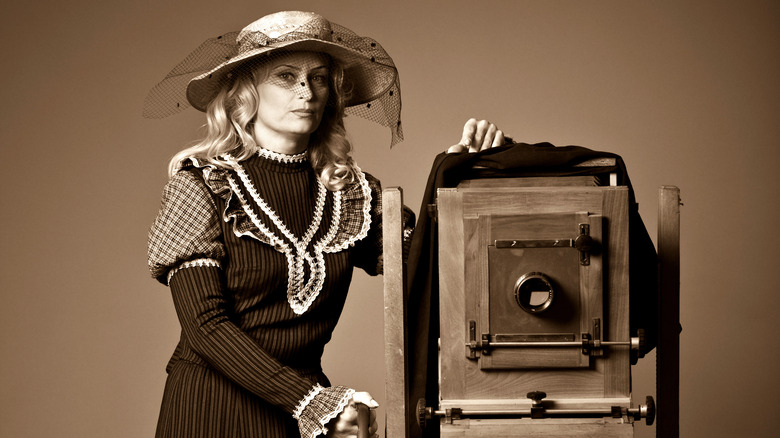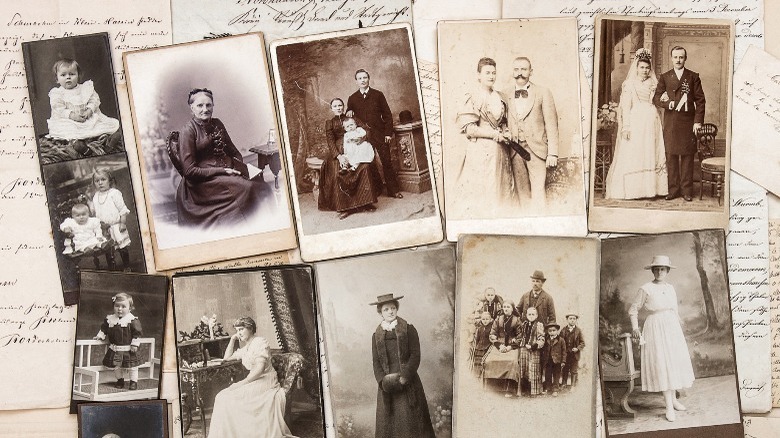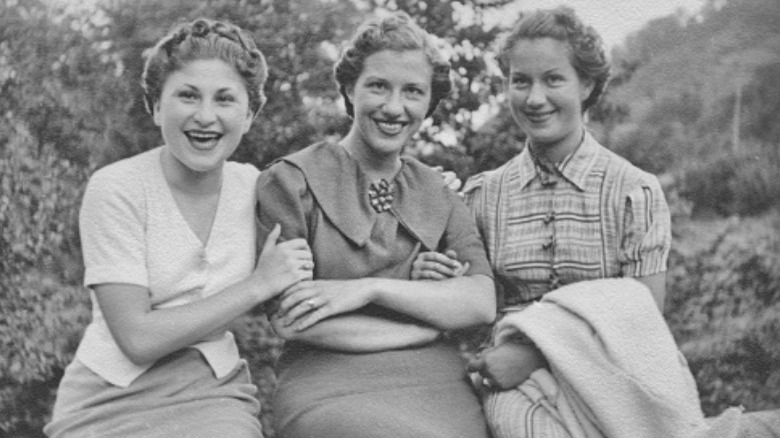Why People Said 'Prunes' Instead Of 'Cheese' While Taking Pictures In The 19th Century
Photography came to the U.S. in 1839, and when looking at portraits from back then, one of the things you notice is that the subjects never smiled. A majority of monochrome prints from the 18th century show people in regal poses with serious faces, and the lack of color adds to the somber mood. One of the reasons why subjects didn't smile was because of the time it took to take a photograph in the early years of photography, according to Time. It was easier to hold a pose with relaxed facial muscles than to hold a smile steady for about 20 minutes, which was how long it took to take a photo back then (via Digital Public Library of America). Subjects had to remain completely still, as even small movements resulted in blurred photos.
By the early 1840s, however, the exposure time of a photograph was decreased to 20 seconds. Still, people maintained serious expressions when their photos were taken. Experts say that it had to do with how portraits were done before the invention of photography. Just like early photographs, paintings also portrayed subjects sans smiles, which was the proper etiquette back then. There were some painted wearing a hint of a smile, but they were faint upturns of the corners of the mouth and didn't show teeth. According to Domestika, there were a few portrait artists who painted smiling subjects, but it was their unique style rather than the norm back then.
The proper etiquette and the standard of beauty
In Nicholas Jeeves' essay for The Public Domain Review, he noted that for a long time, smiling was "deeply unfashionable." Historian Christina Kotchemidova expounded on that thought by writing that grinning or smiling was associated with "peasants, drunkards, children, and halfwits, suggesting low class or some other deficiency," which explains the serious expressions seen in early photographs. Another reason for not smiling was that back then, many didn't have access to good dental care, which left them with broken or no teeth, and that wasn't something they wanted to be immortalized in a photo (via Peta Pixel).
In the early years of photography, people had to go to studios to have the portraits taken, and it was typically for a special occasion. According to Time, photographers set up their studios with elegant decorations, and people showed up wearing their best clothes. They were directed on how to pose and hold their faces in order to get a crisp image free of blurs. Per The Washington Post, the first portrait photographer in Britain, Richard Beard, instructed his subjects to say the word "prunes" when taking their photograph. That kept the muscles in the face controlled and the mouth small, which was a standard of beauty back then. It followed British etiquette of controlling the show of emotions in public settings.
When did prunes change to cheese?
Today, anyone can easily get their hands on a camera and take hundreds of photographs easily. In the 19th century, however, not everyone had the opportunity to get their photograph taken. As writer Mark Twain once said, per Domestika, "A photograph is a very important document, and there is nothing more damning for posterity than a silly smile captured forever." That changed when affordable cameras became available to the masses.
According to The Met, Kodak launched Kodak #1 in 1888. The simple camera, which came with 100 exposures, allowed many people to dabble in amateur photography. Their slogan was, "You press the button, we do the rest." When the roll was finished, users sent the camera back to Kodak for film processing, and they were sent their photos back. Without going into the studio to formally pose and having the ability to capture everyday moments, more smiles were captured. As reported by Time, smiling became the common expression when taking photos around the 1920s. Todd Gustavson, the curator at the George Eastman Museum, said, "Take the camera out of the professional and put it into the hands of the snapshot photographer and then they can do whatever they want."
As for saying "cheese" when smiling for a photograph, no one can say for certain who started the trend, but it has been used at least as early as the 1940s. A 1943 article from a Texas newspaper titled "Need to Put on a Smile? Here's How: Say 'Cheese'" is proof of that (via The Phrase Finder).


